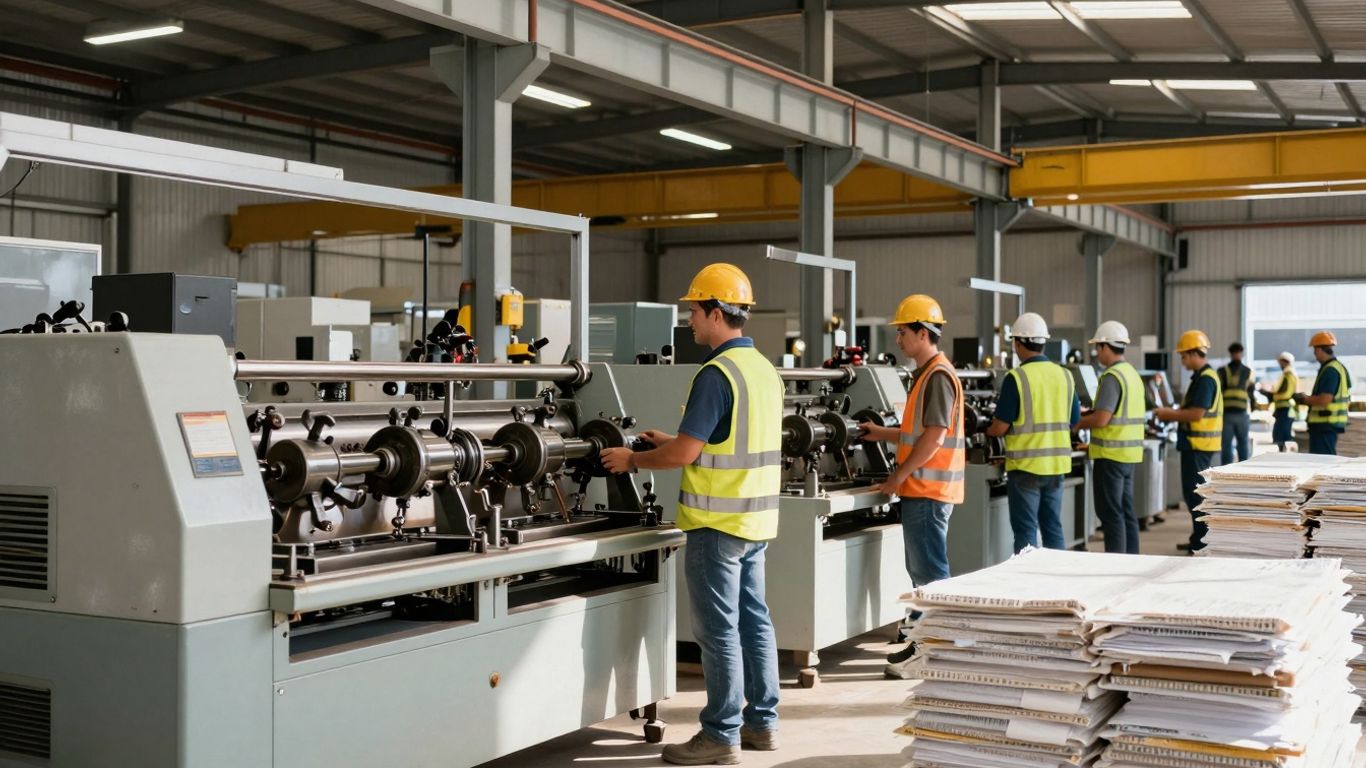Thinking about what the average Australian annual income looks like for 2025? It’s a bit of a mixed bag, really. We’ve got tax changes coming up that might put a bit more cash in your pocket, but then there’s the cost of living, which seems to be going up everywhere. Plus, where you live in Australia can make a big difference to what you earn. Let’s break down what you need to know about the average Australian annual income.
Key Takeaways
- The average Australian annual income is influenced by many things, including where you live and the industry you work in.
- Upcoming tax cuts are set to provide some relief for average earners, potentially increasing disposable income.
- There are significant differences in earnings between states and territories, as well as urban and regional areas.
- The rising cost of living, particularly rent, means that even those earning a good income can feel the pinch.
- Certain professions, especially in healthcare, technology, and finance, offer higher earning potential due to high demand and specialised skills.
Understanding the Average Australian Annual Income Landscape
Trying to get a handle on what the average Aussie earns each year can feel a bit like chasing a moving target. It’s not just one number, you know? Lots of things play into it, and what’s considered a good income can change depending on where you live and what you do for a living. The Australian Bureau of Statistics (ABS) reported an average weekly wage of $1,888.80 in November 2023, which works out to roughly $98,000 annually. But it’s important to remember that this is just an average, and the middle ground, or median salary, is actually closer to $65,000. So, while some people are pulling in big salaries, there’s a pretty wide spread across the country.
Defining the Average Australian Annual Income
When we talk about the average Australian annual income, we’re generally looking at the mean earnings of full-time workers. This figure gives us a broad snapshot, but it can be skewed by very high or very low earners. It’s often helpful to also consider the median income, which represents the midpoint – half of earners make more, and half make less. For 2025, projections suggest a moderate increase, with the average salary hovering around the $98,000 mark, though this is before taxes are taken out. Keep in mind that this number can vary quite a bit based on your specific circumstances.
Factors Influencing Income Across Australia
So, what makes incomes different from one person to the next? A bunch of things, really. Your job is a big one, obviously. Some industries, like mining and tech, tend to pay more than others. Then there’s experience – the more you’ve done something, the more you can usually expect to earn. Location matters a lot too; living in a big city like Sydney or Melbourne might mean a higher salary, but it also usually comes with a higher cost of living. On the flip side, regional areas might offer lower pay but also have cheaper expenses. Education and skills also play a massive role in how much you can earn. The Australian job market is always changing, so staying adaptable is key.
Key Economic Indicators for Income Analysis
To really understand income trends, we need to look at a few key economic indicators. The Consumer Price Index (CPI) tells us how much the cost of everyday goods and services is changing, which directly impacts how far your money goes. The Wage Price Index (WPI) tracks how wages themselves are moving across different industries. These figures help paint a picture of whether incomes are keeping pace with the cost of living. For instance, while wages might be growing, if prices are rising even faster, people can feel like they’re going backwards. It’s a balancing act, and these indicators help us see where we stand.
Navigating Tax Changes and Their Impact
So, let’s talk about taxes. It’s not exactly the most thrilling topic, but it’s pretty important when we’re looking at what’s actually left in your pocket after payday. For 2025, there are a few things on the horizon that could shake things up for the average Aussie earner.
Upcoming Tax Cuts for Average Earners
There’s been a lot of talk about tax cuts, and for many people earning an average income, this could mean a bit more breathing room. The idea is to adjust the tax brackets, so people aren’t pushed into higher tax tiers just because of inflation or small pay rises. This adjustment aims to provide some relief and potentially boost spending power. It’s not a massive overhaul, but for those feeling the pinch, every bit helps, right?
Impact of Tax Adjustments on Household Budgets
When tax rates change, even slightly, it can ripple through your household budget. If you’re taking home a bit more each fortnight, you might be able to put more towards savings, pay down debt, or just cover those ever-increasing everyday costs. On the flip side, if any changes mean you’re paying more, it could mean tightening the belt a bit more. It’s all about how these adjustments affect your disposable income – that’s the money you actually have left to spend or save after all the essential bills are paid.
Strategies for Optimising Taxable Income
Beyond the headline tax changes, there are always ways to be smart about your tax situation. Thinking about things like salary sacrificing into superannuation can reduce your taxable income now and help your retirement savings grow. Also, keeping good records of any work-related expenses you’ve incurred throughout the year is a must. These can often be claimed as deductions, further lowering the amount of income the tax office considers taxable. It’s worth looking into what deductions you might be eligible for, as it can make a real difference to your final tax bill. For more detailed information on how these changes might affect you, checking out resources from the Australian Taxation Office is a good start, or perhaps speaking with a tax professional.
It’s easy to get bogged down in the details of tax legislation, but at the end of the day, it’s about understanding how these rules affect your personal finances and making informed decisions. Small changes can add up over time, so staying aware of what’s happening with taxes is always a good idea.
Regional Variations in Earnings
Australia’s a big place, and where you hang your hat can really change how much cash is coming in. It’s not just about the big cities versus the bush; even between states, there are noticeable differences in what people earn. Understanding these regional income disparities is key to getting a real picture of the Australian earning landscape.
Income Disparities Between States and Territories
When you look at the numbers, some states consistently pull in more than others. For instance, Western Australia and the Australian Capital Territory often lead the pack, with full-time workers earning well over the national average. On the flip side, places like Tasmania and South Australia tend to sit a bit lower on the earnings scale. It’s a complex mix of industry presence, cost of living, and local economic drivers that shapes these figures.
Here’s a rough idea of how some states stack up:
- Western Australia: Often sees the highest weekly earnings, with averages exceeding $2,000.
- Australian Capital Territory: Usually comes in second, with averages around $2,022 weekly.
- New South Wales & Victoria: Generally hover close to the national average, around $1,830 weekly.
- Queensland: Tends to be slightly below the national average, around $1,791 weekly.
- South Australia: Falls further below, with averages around $1,677 weekly.
- Tasmania: Typically has the lowest average weekly earnings, around $1,619.
Urban Versus Regional Earning Potential
Generally, you’ll find higher average salaries in the major capital cities like Sydney and Melbourne. These urban centres are hubs for many high-paying industries, including finance, tech, and corporate services. However, don’t discount regional areas entirely. Some specific regional industries, like mining in Western Australia or certain agricultural sectors, can offer very competitive wages, sometimes even exceeding those in capital cities, especially when you factor in remote work allowances. It really depends on the specific industry and location.
The idea that all regional areas pay less isn’t quite right. While major cities often have more diverse high-paying job opportunities, specialised industries in regional Australia can offer excellent remuneration, particularly when considering the often lower cost of living in those areas.
Highest and Lowest Earning Regions
Looking at the data, Western Australia, particularly its resource-rich areas, often shows the highest average incomes. The Australian Capital Territory, driven by government and public sector employment, also consistently ranks high. On the other end of the spectrum, Tasmania and parts of South Australia frequently appear as regions with lower average earnings. These differences highlight how Australia’s economic landscape is far from uniform, with significant variations influencing the financial well-being of residents across the country. For a more detailed look at national income figures, checking out the Australian Bureau of Statistics is a good start ABS data.
The Cost of Living and Its Relation to Income

It’s pretty obvious that what you earn and what you spend are linked, right? Like, if rent goes up, you’ve got less cash for, I don’t know, avocado toast. Understanding how your income stacks up against the general cost of living is super important for actually knowing where you stand financially. It’s not just about the big numbers; it’s about what’s left in your pocket after all the essentials are paid for.
Affordability Challenges for Renters
Rent is a massive chunk of most people’s budgets, especially in the big cities. We’re talking about places like Sydney, where the average rent for a one-bedroom place can be around $3,261.50 a month. That’s a serious amount of money before you even think about groceries or bills. It makes sense why people are looking at places like Melbourne, which is generally a bit cheaper, or even considering regional areas for a breather. Finding a place you can afford, especially if you’re on an average income, can be a real struggle.
How Expenses Affect Disposable Income
So, you get paid, and then the bills start rolling in. Rent, electricity, water, internet, maybe a car payment, and don’t forget food. All these things chip away at your pay cheque. What’s left over is your disposable income – the money you can actually spend on whatever you want, like going out or saving up. If your expenses are high, your disposable income shrinks, meaning less freedom to do the fun stuff or build up savings. It’s a constant balancing act.
Measuring the Cost of Living in Australia
Figuring out the cost of living isn’t just a simple sum. The government uses things like the Consumer Price Index (CPI) to track how prices change over time for a basket of goods and services. They also look at Living Cost Indexes (LCIs) to see how much it costs to maintain a certain lifestyle. It’s not just about what things cost, but how those costs change relative to wages. For instance, while Perth might be a bit more expensive overall than Sydney for daily expenses, the rent savings can make a big difference. It really depends on where you are and what your priorities are. You can find more details on housing market trends at Australian housing market.
Here’s a rough idea of monthly costs (excluding rent) for a single person in some major cities:
| City | Estimated Monthly Cost (Excl. Rent) |
|---|---|
| Sydney | $1,773.70 |
| Melbourne | $1,746.00 |
| Brisbane | $1,773.70 |
| Perth | $1,836.00 |
It’s easy to get caught up in the headline income figures, but the real picture of financial health comes from looking at what’s left after all the bills are paid. That’s the money that actually gives you choices.
Future Trends in Australian Earnings
Looking ahead to 2025 and beyond, the Australian earnings landscape is set for some interesting shifts. We’re seeing a mix of factors influencing how much people can expect to take home, from government policies to the overall health of the economy. It’s not all about big numbers though; how far that money goes is just as important.
Projected Wage Growth and Labour Market Tightness
Right now, the labour market is pretty tight, meaning there are more jobs than people to fill them. This is good news for workers because it usually means employers have to offer better pay to attract staff. We’re expecting wage growth to be around 3.25% in the coming year. While that’s not as high as the super-charged growth we saw right after the pandemic, it’s a more sustainable, long-term average. This steady growth means more people are earning, which generally leads to more spending in the economy. The unemployment rate is also expected to stay low, hovering around 4.25%, which reinforces this idea of a strong job market.
Impact of Migration Policies on Income
Government policies are also playing a role, particularly around migration. The plan is to gradually reduce net overseas migration. The idea behind this is to ease pressure on things like housing and to help bring down inflation. For industries that have relied on migrant workers, like retail and hospitality, this could mean changes. However, the government is also focusing on bringing in skilled workers to fill specific job shortages. If this is managed well, it could help fix some of the skill gaps we’re seeing and keep wages from going too high too fast.
Economic Outlook for Australian Salaries
Overall, the economic outlook suggests a stable, if not slightly slower, growth period for salaries. The government’s budget is expected to be less impressive than in recent years, partly because high commodity prices and a strong labour market aren’t expected to continue at the same pace. However, the underlying strength in employment means that most Australians should continue to see their incomes supported. It’s a balancing act, trying to keep inflation in check while also making sure people can earn a decent living. The average monthly salary is projected to be around $7,600 AUD, which is a decent figure when you consider the cost of living, though that’s a whole other story.
The interplay between a tight labour market, government policy on migration, and broader economic conditions will shape how Australian salaries evolve. While rapid wage increases might be a thing of the past for now, a stable job market offers a solid foundation for earnings.
High-Demand Professions and Earning Potential

So, you’re curious about which jobs are really paying off in Australia right now? It’s not just about having a job; it’s about finding one that offers good financial rewards and a solid future. The Australian job market is pretty dynamic, with certain sectors consistently showing strong demand for skilled workers. These fields often require specialised training or advanced degrees, but the payoff can be significant. Understanding where the opportunities lie can really help shape your career path.
Sectors Driving High Salaries
Several industries are consistently at the forefront when it comes to offering competitive salaries. These are the areas where businesses are actively seeking out talent, often due to rapid growth, technological advancements, or a critical need for specialised skills. Think about healthcare, where the demand for medical professionals is always high, or the booming technology sector, which needs people who can build and secure digital systems. Engineering, particularly in areas like mining and infrastructure, also commands high salaries due to the technical expertise and often challenging work environments involved. Finance is another big one, with roles in investment banking and financial management being particularly lucrative.
Top Earning Careers in Australia
When we look at the actual job titles, some stand out for their earning potential. For instance, medical specialists like neurosurgeons and anaesthetists are consistently among the highest paid, reflecting the extensive training and responsibility involved. CEOs of major companies also feature prominently, as do roles like investment bankers and IT security architects. Even in engineering, positions like mining engineers can bring in substantial incomes. It’s interesting to see how specialised knowledge and leadership translate directly into higher pay packets. You can find more details on the top 10 highest paying jobs in Australia for 2025.
Skills in Demand and Their Remuneration
What specific skills are employers willing to pay top dollar for? It really boils down to a mix of technical know-how and in-demand expertise. Here are a few examples:
- Advanced Medical Skills: Specialised medical practitioners, particularly surgeons and anaesthetists, require years of study and practical experience, leading to very high remuneration.
- Cybersecurity Expertise: With the increasing threat of cyberattacks, IT security architects and professionals with strong cybersecurity skills are highly sought after and well-compensated.
- Financial Acumen: Roles like investment bankers and financial managers, who can navigate complex markets and manage significant assets, are rewarded handsomely.
- Engineering Specialisations: Particularly in mining and resource extraction, mining engineers with specific skills are in high demand.
The Australian economy continues to show resilience, with strong labour demand in key sectors. This translates into good opportunities for those with specialised skills, particularly in fields like healthcare, technology, and engineering. While general wage growth might be steady, these high-demand professions often see salaries that significantly outpace the average.
It’s clear that investing in specialised education and skills development can really open doors to some of the most rewarding careers financially. The landscape is always shifting, but these core areas seem to be strong bets for earning potential in the coming years.
So, What’s the Takeaway for 2025?
Alright, so we’ve looked at the numbers, and it’s clear that earning a decent crust in Australia in 2025 means understanding a few things. While the average income figures give us a general idea, remember that where you live and what you do for a living really shakes things up. Plus, with those upcoming tax cuts and the ongoing chat about cost of living, especially rent, it’s a bit of a mixed bag. It’s not just about the headline average; it’s about how these changes actually land in your pocket and affect your day-to-day. Keep an eye on those economic shifts, because they’ll definitely shape how far your hard-earned dollars go.
Frequently Asked Questions
What’s the average yearly income in Australia?
The average yearly income in Australia for a full-time worker is about $98,000, but this can change a lot depending on your job and where you live. Many people earn less, with the middle income being closer to $65,000.
Will there be tax cuts in 2025?
Yes, tax cuts are coming! From July 2024, and more in 2026 and 2027, many Australians will pay less tax. For example, someone earning the average income could see their tax bill drop by over $2,000 per year by 2027-28 compared to now.
How much money do I need to live comfortably in Australia?
Living costs like rent, groceries, and bills have gone up. To live comfortably, a single person outside big cities might need around $70,000 to $80,000 a year. Rent is a big part of this, with many people needing to earn over $130,000 to afford the average rent without stress.
Which parts of Australia pay the most?
Western Australia and the Australian Capital Territory usually have the highest average incomes. Places like Tasmania and South Australia tend to have lower average earnings compared to the rest of the country.
What jobs pay the most in Australia?
Jobs in healthcare, like neurosurgeons and anaesthetists, often pay the most, sometimes over $600,000 a year. Other high-paying jobs include CEOs, investment bankers, and mining engineers.
What are the plans for wages and jobs in the future?
The government is trying to manage inflation and help the job market. They expect wage growth to be around 3-3.25% each year, which is more steady than the higher growth seen after the pandemic. They also plan to slightly reduce migration to help ease demand on things like housing.





